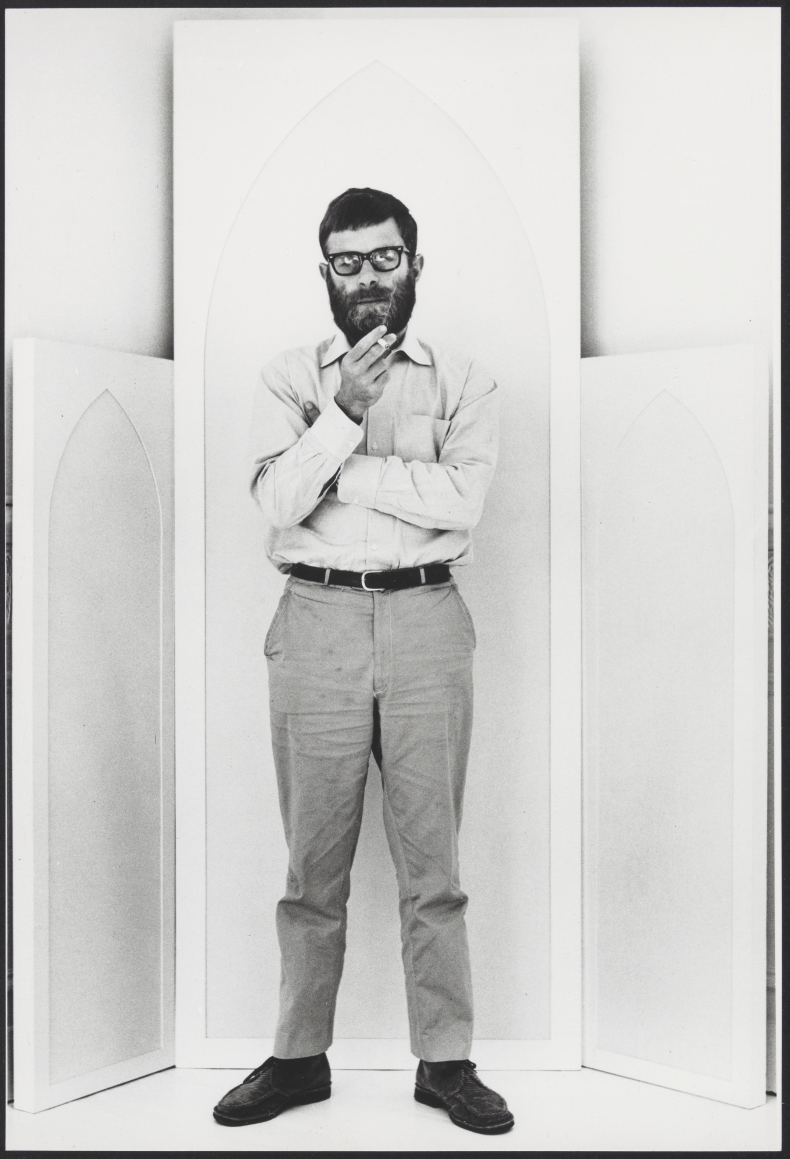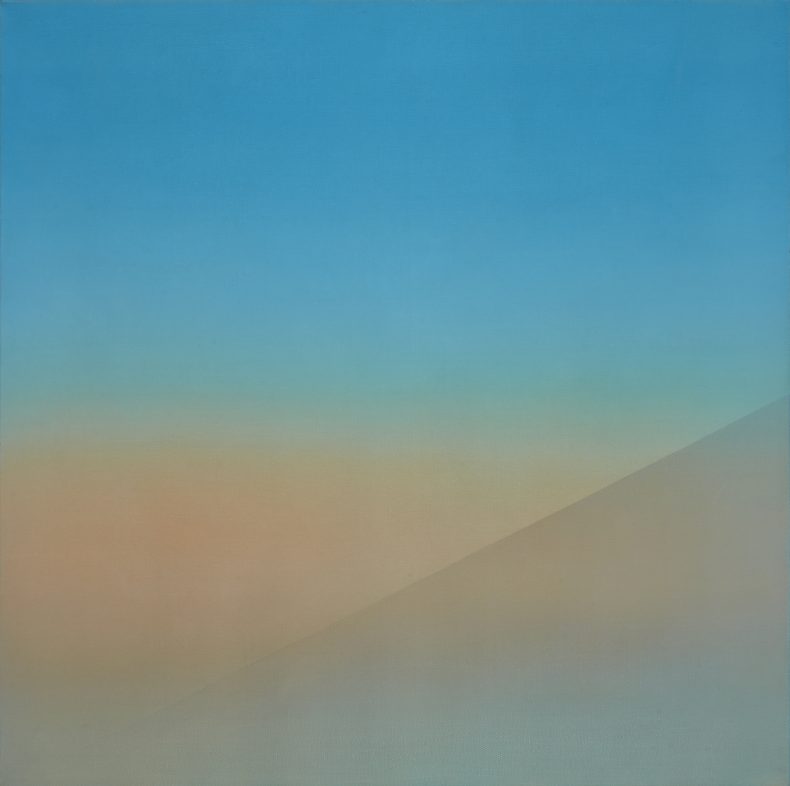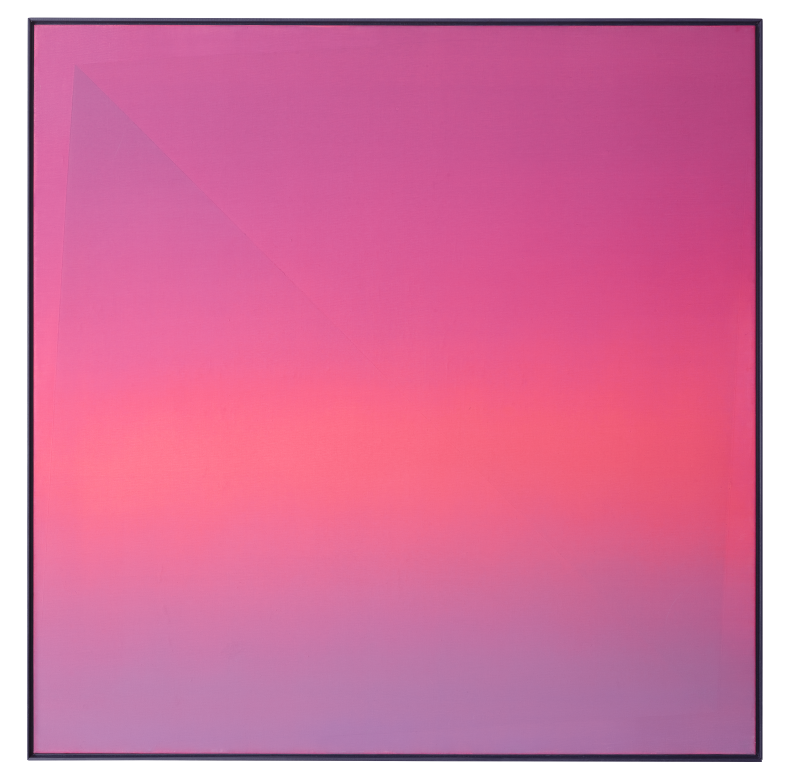Outside Antwerp’s Royal Museum of Fine Arts (KMSKA) hangs a large banner displaying a full-length photograph of an unfamiliar man. With one hand holding a lit cigarette and the other tucked under his armpit, this figure, with his thick-rimmed glasses, looks like any other bearded intellectual of the 1950s. A leading light of Antwerp’s avant-garde during the ’50s and ’60s, the painter Jef Verheyen is today little known either in Belgium or further afield. Despite being championed by his friend and admirer the art dealer Axel Vervoordt, he had until recently – as a monograph that accompanied a 2011 exhibition in Neuss, Germany, puts it – ‘fallen into oblivion’.
Since then, although scholarship has repositioned him clearly within the fertile context of European post-war abstraction, his unique achievement is still little understood. Perhaps this is because unlike many of his peers, Verheyen stuck by the painted two-dimensional surface while others recruited more overtly radical media, including mixed materials, performance and installation. Or perhaps it’s because of his particularly fervent pursuit of what the artist Otto Piene – co-founder of the Düsseldorf-based movement ZERO, which pioneered new uses of light and movement in art – defined as ‘a zone of silence and of pure possibilities for a new beginning’; a quest so resolutely spiritual, even mystical, that it has made it hard for successive generations to understand him.

Jef Verheyen in 1967. FOMU Antwerpen. Photo: Filip Tas; © SABAM Belgium 2024
This first solo museum show for the artist in Antwerp, organised jointly by KMSKA and the Museum of Contemporary Art Antwerp (M KHA) and accompanied by a comprehensive catalogue, is intended to make ‘le peintre flamant’, as he styled himself, well known again. Just a year after its triumphant reopening, KMSKA has dedicated 10 galleries to this native son. An opening gallery distils the salient elements of Verheyen’s story and evokes the art-historical context through works by his friends and associates Günther Uecker and Lucio Fontana, who challenge the definition of painting with, respectively, a crude wooden frame embedded with nails, and a slit canvas from Fontana’s ‘Spatial Concept’ series, from 1960. Here also is the empty steel frame (Le Vide) that Uecker and Verheyen installed in a field in East Flanders in 1967 as part of the open-air exhibition ‘Flemish Landscapes’, a provocation to understand Verheyen’s project as offering a portal into the void or infinite space. And there is one of his late paintings, Venus Saphira, finished the year before he died of a heart attack in 1984, its graded blues, as if lit from behind by the sun, laid in matt lacquer on the canvas so no brushstroke can be perceived and the viewer can plunge, unimpeded by figurative content or traces of the artist’s action, into its illusory depths.

Jef Verheyen holding his artwork Le Vide (1965) in c. 1965. FOMU Antwerpen. Photo: Gerald Dauphin; © SABAM Belgium 2024
The exhibition then proceeds to one of the earliest phases of Verheyen’s career: ceramics. In 1953 Verheyen and his fellow student and wife, Dani Franque, persuaded the Royal Academy of Fine Arts, where he was a student, to start a ceramics class. Though this son of a house painter had long harboured ambitions to become an artist, it was in glazes and the monochrome ceramics of Song China that he first found creative excitement and a route towards an avant-garde visual language. A stint in Vallauris, known to be a ceramics hub, was followed by the couple’s return to Antwerp and the establishment in 1955 of a ceramics studio and shop. But painting drew Verheyen back. His first canvases, shown here, reflect his deep admiration for Paul Klee, Kazimir Malevich, Piet Mondrian, Mark Rothko and his own countryman Jozef Peeters in their compositions and approach to colour, though there is a distinctive sense of depth behind the surface forms, as if the abstract shapes themselves are in the way.

Dream of Möbius (1962), Jef Verheyen and Lucio Fontana. Jef Verheyen Archive, Mechelen. Photo: Jan Liégeois; © SABAM Belgium 2024
Verheyen’s first trip to Milan, in 1957, transformed his mission once more. There he met Fontana, who would, a year later, buy Verheyen’s new red monochrome painting The Air is Full of Your Warmth and become his friend until Fontana’s death in 1968. On show in another room is the canvas Dream of Möbius, on which they collaborated in 1962, amid a selection of works by fellow travellers past and present. Alongside Fontana, Piero Manzoni enabled Verheyen to understand the power of monochrome painting to liberate the canvas from representation; Yves Klein confirmed for him the potential of pure colour.

The Air is Full of Your Warmth (1958), Jef Verheyen. Fondazione Lucio Fontana, Milan. Photo: Fondazione Lucio Fontana; © SABAM Belgium 2024
The room titled ‘Van Gogh to Verheyen: Seekers of Light’ holds the Belgian’s most outstanding canvases. These intense, shimmering evocations of space and light, some inspired by particular places, in greens, blues, golds, ochres and browns, are constructed with very fine layers of colour – like the glazes of the Flemish Primitives, but in matt lacquer.
Later he would use geometrical interventions, borders and architectural frameworks to guide the eye. But just as sometimes the conscientious curation feels distractingly busy, so Verheyen occasionally overcomplicates what in other instances is a unique and sublime achievement.

Untitled (Hommage à Van Gogh) (1976), Jef Verheyen. Private collection. Photo: Jan Liégeois/Axel Vervoordt Gallery; © SABAM Belgium 2024
As important to understanding Verheyen as these 10 galleries are the ones upstairs, which house the museum’s permanent collection. Here you can find Hans Memling’s Man with a Roman Coin (c. 1480) or Quentin Matsys’ Saint Christopher (1490) and see for yourself the clear line from their deep skies and seas to Verheyen’s work. As he put it at the outset of his career, in his manifesto Essentialism (1958–59), what he was after for himself and the audience was a feeling beyond vision – a ‘Falling, flying off into space’.

The Morning of the Magicians (1979), Jef Verheyen. Jef Verheyen Archive, Mechelen. Photo: Jan Liégeois; © SABAM Belgium 2024
‘Jef Verheyen. Window on Infinity’ is at KMSKA, Antwerp, until 18 August.














![Masterpiece [Re]discovery 2022. Photo: Ben Fisher Photography, courtesy of Masterpiece London](http://zephr.apollo-magazine.com/wp-content/uploads/2022/07/MPL2022_4263.jpg)
Suzanne Valadon’s shifting gaze